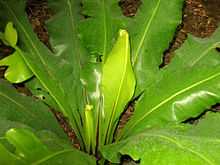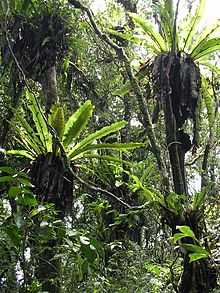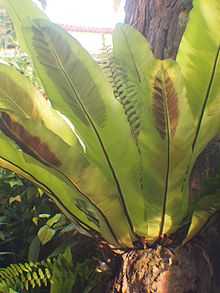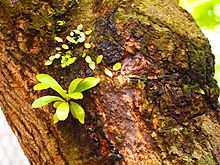Asplenium nidus
- See bird's-nest fern for other plants with this common name.
| Asplenium nidus | |
|---|---|
 | |
| Conservation status | |
| Scientific classification | |
| Kingdom: | Plantae |
| Division: | Pteridophyta |
| Class: | Polypodiopsida |
| Order: | Polypodiales |
| Family: | Aspleniaceae |
| Genus: | Asplenium |
| Species: | A. nidus |
| Binomial name | |
| Asplenium nidus L. [1] | |
| Synonyms[2] | |
Asplenium nidus is an epiphytic species of fern in the family Aspleniaceae, native to tropical southeastern Asia, eastern Australia, Hawaii, Polynesia, Christmas Island, India, and eastern Africa. It is known by the common names bird's-nest fern[1][3] (a name shared by other aspleniums) or simply nest fern.[3]
Description
Asplenium nidus forms large simple fronds visually similar to banana leaves, with the fronds growing to 50–150 cm long and 10–20 cm broad. They are light green, often crinkled, with a black midrib, and exhibit circinate vernation. Spores develop in sori on the underside of the fronds. These sori form long rows extending out from the midrib on the back of the outer part of the lamina (frond). The fronds roll back as they brown and create a massive leaf nest in the branches and trunks of trees.
Native distribution

Asplenium nidus is native to east tropical Africa (in Tanzania, inclusive of the Zanzibar Archipelago); temperate and tropical Asia (in Indonesia; East Timor; the prefecture of Kyushu, and the Ryukyu Islands of Japan; Malaysia; the Philippines; Taiwan; and Thailand); and in Australasia (in the northern part of Queensland in Australia).[3]
Habitat
Asplenium nidus can survive either as an epiphytal, or terrestrial plant, but typically grows on organic matter. This fern often lives in palm trees or bromeliads, where it collects water and humus in its leaf-rosette. It thrives in warm, humid areas in partial to full shade.
Uses


With a minimum temperature of 10 °C (50 °F), Asplenium nidus is widely cultivated in temperate regions as a houseplant.[4] Apparently, most plants sold in America as A. nidus are actually Asplenium australasicum, which has longer sori, and a differently shaped midrib.(R. J. Johns, in the 2001 Flora Malesiana Symposium)
Asplenium nidus has been used locally in folk medicine (to treat asthma, sores and weakness) and hygienically to treat halitosis.[5]
This plant has gained the Royal Horticultural Society's Award of Garden Merit.[6]
The sprouts of A. nidus are eaten as a vegetable in Taiwan. In Taiwan this plant is called 山蘇 (pronounced shān sũ) and typically cut into inch length pieces and fried with garlic and chilli peppers.
Protection
In Hong Kong, this species is under protection based on Forestry Regulations Cap. 96A.
See also
| Wikimedia Commons has media related to Asplenium nidus. |
References
- ↑ 1.0 1.1 Asplenium nidus was first described and published in Species Plantarum 2: 1079. 1753. "Name - !Asplenium nidus L.". Tropicos. Saint Louis, Missouri: Missouri Botanical Garden. Retrieved November 3, 2011.
- ↑ "Name - !Asplenium nidus L. synonyms". Tropicos. Saint Louis, Missouri: Missouri Botanical Garden. Retrieved November 3, 2011.
- ↑ 3.0 3.1 3.2 GRIN (April 14, 1995). "Asplenium nidus information from NPGS/GRIN". Taxonomy for Plants. National Germplasm Resources Laboratory, Beltsville, Maryland: USDA, ARS, National Genetic Resources Program. Retrieved November 3, 2011.
- ↑ RHS A-Z encyclopedia of garden plants. United Kingdom: Dorling Kindersley. 2008. p. 1136. ISBN 1405332964.
- ↑ James A. Duke. "Asplenium nidus (ASPLENIACEAE)". Dr. Duke's Phytochemical and Ethnobotanical Databases. Retrieved November 3, 2011.
- ↑ "RHS Plant Selector - Asplenium nidus". Retrieved 5 June 2013.
Further reading
- (Portuguese) LORENZI, H.; SOUZA, M.S. (2001) Plantas Ornamentais no Brasil: arbustivas, herbáceas e trepadeiras. Plantarum ISBN 85-86714-12-7
External links
| Wikispecies has information related to: Asplenium nidus |
